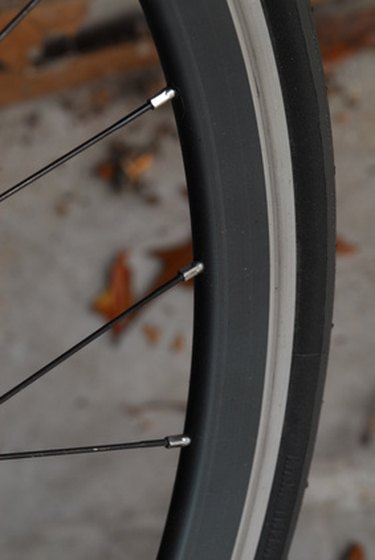
You may look at your bicycle tires as something you are fully happy with as long as they don't go flat. But important components of their construction enable tires to contact the road safely, hold their shape and protect the inner tube. Underneath the rubber tread design of your bicycle tire is a structure called a casing, made of nylon threads. These threads are measured in tpi, which stands for threads per inch.
Significance
Video of the Day
Rubber is the least important component of your tire, bicycling editor and racer Jayme Otto notes. The bead, the edge of the tire that tucks into the rim, and the casing, woven between the two beads, are the nuts and bolts of the tire, she states. Generations ago, casings were made of cotton canvas, but in the 1960s, manufacturers switched to nylon, which has superior tensile strength. High-end tires feature Kevlar, a strong, light fiber. The casing uses layers of threads, measured in tpi, laid side by side and placed in layers perpendicular to each other.
Video of the Day
Function
A larger thread equates to a lower tpi and a stiffer casing, notes former professional cyclist Ian Dille writing in Mountain Bike magazine. A standard downhill mountain bike tire might use a 60 tpi casing, while a performance cross-country tire or road bike tire might be 120 tpi. A smaller thread size, he notes, makes for higher tpi and less rubber packed between the threads, making the tire lighter and more supple on the road. Cross-country tires have a single sheet of casing bonded under the center of the tread, Dille writes, while all-mountain tires use a two-ply casing.
Types
Tire manufacturer Vittoria has the highest tpi in the industry, Otto notes, with a tire at 320 tpi; the company also makes road tires down to 26 tpi, with an average of 120 tpi. Michelin North America notes on its website that it offers 33 tpi for entry-level tires or for abusive situations like downhill racing or freeriding, 60 tip for intermediate range tires and 127 tip for top-range tires. Taiwan-based Maxxis notes online that most of its tires are 60 tpi except for its 120 tpi racing tires.
Considerations
A beginning racer should find a tire that provides the best value based on lightness, tpi count and the smoothness of the ride, writes Robert Panzera in "Cycling Fast." The price differential is about $50 between the highest tpi and the lowest, Otto states.
Expert Insight
Cycling author Natascha Grief notes in "Bicycling" magazine that a higher tpi becomes most noticeable when cornering, as the tire better conforms to the road's surface. While lower thread count tires do not offer the ride quality of a 120-tpi tire, they are more resistant to cuts and flats. If you want a high-mileage tire, go for a lower tpi; if you want a high-performance tire that will roll faster and corner better, select a higher tpi, she advises.